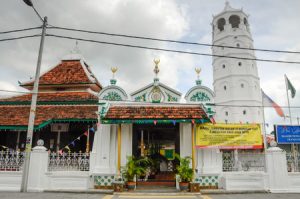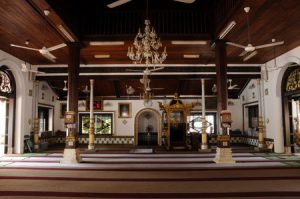What Makes A Mosque, Part 4: A Mosque in Malaysia
Nothing about the Tengkera Mosque of Malacca City says “Islam” to a Western observer. Its three-tiered roof and elaborate entrance gate would be at home in any Chinatown in America. The freestanding octagonal tower looks more like a pagoda than a minaret. Built in 1728, the Tengkera Mosque reflects the melting pot character of the Melaka Sultanate during its heyday.
The city of Melaka was founded in 1402 by a fugitive Hindu prince from Sumatra who subsequently converted to Islam to please a powerful father-in-law. Prince Paramesvara chose his location well. He built his new city on the deepest natural port on the Straits of Melaka, which controlled the trade routes between India and China. By the end of the fifteenth century, Melaka had become an important international trading hub, home to merchants from China, Sumatra, India, and the Middle East.
As the city grew, the size of its foreign immigrant community increased. Each group of immigrants brought new building materials, construction techniques, and architectural styles with them. The result was a building style that one architectural historian has called “Straits Eclectic”: traditional South East Asian timber architecture with Indian and Chinese accents.
Unlike their counterparts in the Middle East and India, the Melaka sultans did not build monumental state mosques. The earliest mosques in the region were nothing more than a pavilion on a raised platform with a thatched roof and one solid wall on the side that faced toward Mecca. Over time, the pavilion developed into a small square building topped with a steeply pitched three-tier tile roof.
In many ways, the final form of the Melaka-style mosque is nothing more than a pavilion with a Chinese party hat. Each tier of the roof is supported by a square of wooden pillars, with the prayer hall centered under the top tier of the roof. The wall of the prayer hall that faces toward Mecca is always solid but the other walls are often nothing more than an open row of pillars. Often there is an open space between roofs to allow air to circulate. On the exterior, the tile roofs sweep upward and end in an elaborate finial.
An elegant solution for a climate very different from the Arabian deserts where Islam was born.
What Makes A Mosque, Part 3: The Great Mud Mosque of Djenne
Unlike the classic blue-tiled mosques of the Middle East, the mosques of West Africa are made from mud brick. That doesn't mean they are simple mud huts. They are complicated and beautiful buildings that combine traditional West African building techniques with the ritual requirements of Islamic worship to make uniquely West African religious spaces.
The most famous West African mosque is the Great Mosque of Djenne, in central Mali. A mosque has occupied the site since 1240, when the city's twenty-seventh ruler, Koy Kumboro, converted to Islam. In order to show his devotion to his new faith, he demolished his palace, and built a mosque in its place. The new mosque was built over a frame of palm timbers using cylindrical sun-dried bricks, about the size and shape of a can of soda pop, and then plastered with a layer of mud. According to Mali legend, the local djinn* helped build it by carrying clay from the desert in baskets on their heads.
Koy Kunboro's mosque dominated the market plaza at the center of Djenne for almost six hundred years. In the early nineteenth century, fundamentalist leader Seku Amadou declared jihad against Djenne in the name of restoring Islam to its true nature. After he captured the city, he abandoned the mosque to the weather. Islamic law forbids the destruction of a mosque, but mud buildings are fragile. Without regular maintenance, the Great Mosque crumbled into ruins.
In 1907, masons skilled in the traditional techniques of mud construction rebuilt the mosque under French rule. Like Notre Dame in Paris, the re-built Great Mosque combines monumentality with verticality. The mosque stands on a raised square plinth and dominates the city's main market square. The major facade, which faces the market, consists of three stepped minarets divided by a series of sharply defined vertical columns. This facade is not the entrance. It is the qibla, which points the way to Mecca.
The oldest sections of the mosque are made from cylindrical bricks; the bricks in the newer sections are rectangular. The building bristles with projecting fan palm timbers, set horizontally into the walls as expansion joints to reduce cracking caused by extreme changes in humidity and temperature.
The timbers also provide permanent scaffolding for the ongoing maintenance required by mud construction. Djenne is taking no chances on losing the Great Mosque to the weather again. Re-plastering the walls after the inevitable damage caused by the rainy season is now a joyous, messy and important element of the local Ramadan festival.
*You may know them as genies.
What Makes a Mosque, Pt. 2: Suleyman the Magnificent Builds A Mosque
Commissioning a mosque was both an act of piety and a political statement in the Ottoman empire. Surrounded by building complexes that provided social services ranging from a public fountain to a caravanserai, mosques anchored new neighborhoods in old cities. Who commissioned what was carefully linked to social status. Small officials commissioned small mosques. Grand viziers commissioned grand mosques. And when the greatest Ottoman emperor and the greatest Ottoman architect teamed up to build a new imperial mosque in Istanbul, you got something, well, magnificent.
In 1550, Suleyman the Magnificent had ruled the Ottoman empire for thirty years. He had defended Islam against Christians to the west and Shiite heretics to the east. He had expanded his empire’s boundaries from Budapest to Basra. He had built mosques everywhere his armies went. Now he was ready to build the big one in Istanbul itself.
Sinan was the acknowledged master of Ottoman architecture. Originally an officer and engineer in the Ottoman army, Sinan had caught the emperor’s eye with his talent for building temporary bridges for an army on the march. Under Suleyman’s patronage, he moved from bridges to buildings when he became Chief Architect of the Ottoman court in 1537. By 1550, Sinan was famous for his treatment of foundations and domes.
Together, Suleyman and Sinan built a mosque that was an Ottoman answer to Hagia Sophia. When the Ottomans conquered Istanbul in 1453, Mehmet the Conqueror physically appropriated the Byzantine cathedral for use as the imperial mosque. Sinan’s act of appropriation was more subtle.
Built a thousand years before the Suleymaniye Mosque, Hagia Sophia is an architectural masterpiece. Its massive elliptical dome seems to float above the nave of the church because it rests on a ring of windows that separate it from the structure. Glittering mosaics dissolve the interior space of the building into shadowy mystery.
Sinan used the same structural scheme as the Hagia Sophia to create a totally different affect in the Suleymaniye Mosque. In a sixteenth century version of form follows function, the structure that holds the dome in place is clearly visible. Instead of disguising the tension between the curves of the dome and the straight horizontal lines of the building below, Sinan accentuates it. The result? The dome of heaven soars above the human world of prayer.





